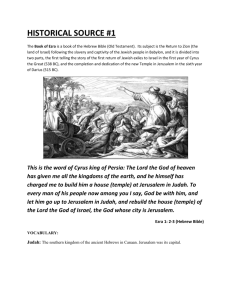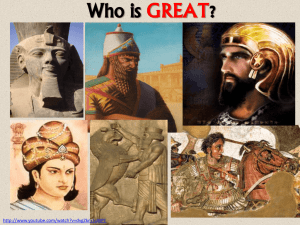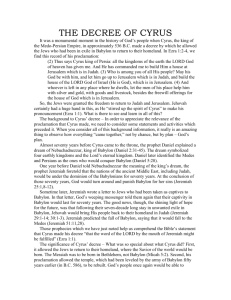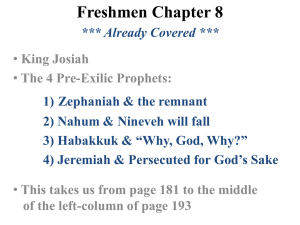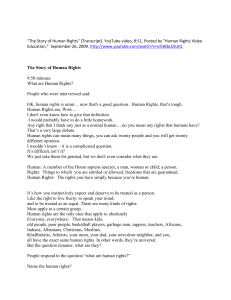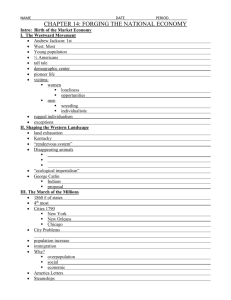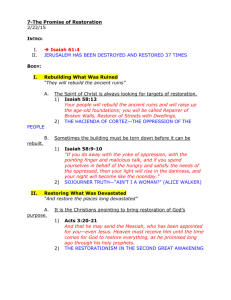The Cyrus Cylinder - North Main Church of Christ
advertisement
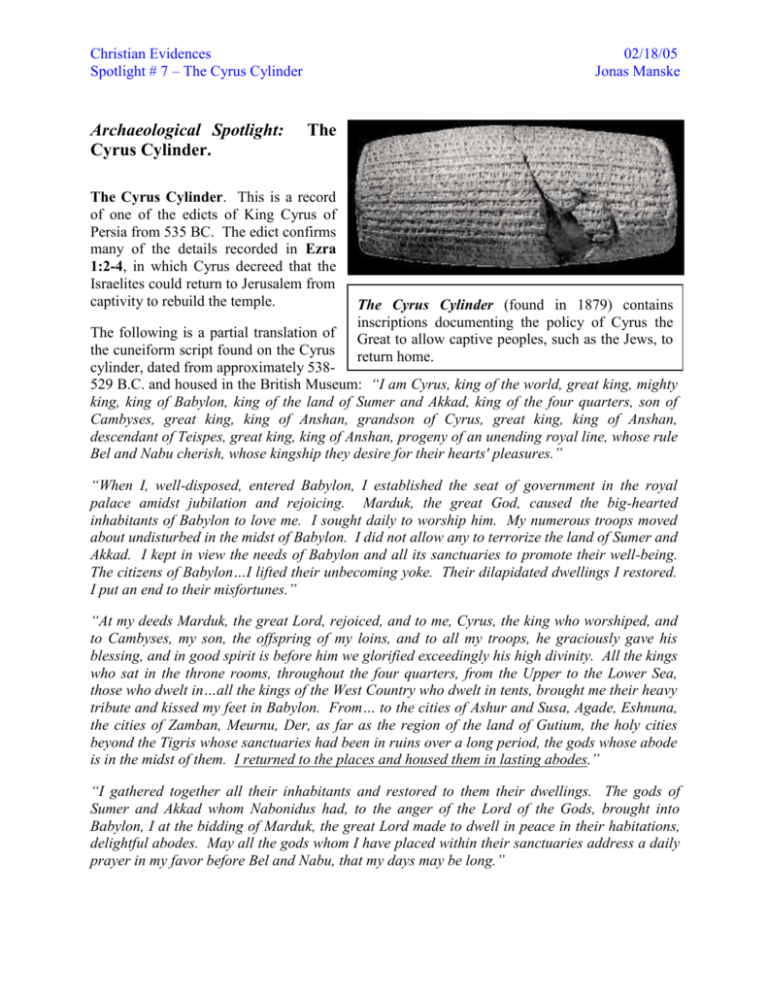
Christian Evidences Spotlight # 7 – The Cyrus Cylinder Archaeological Spotlight: Cyrus Cylinder. 02/18/05 Jonas Manske The The Cyrus Cylinder. This is a record of one of the edicts of King Cyrus of Persia from 535 BC. The edict confirms many of the details recorded in Ezra 1:2-4, in which Cyrus decreed that the Israelites could return to Jerusalem from captivity to rebuild the temple. The Cyrus Cylinder (found in 1879) contains inscriptions documenting the policy of Cyrus the Great to allow captive peoples, such as the Jews, to return home. The following is a partial translation of the cuneiform script found on the Cyrus cylinder, dated from approximately 538529 B.C. and housed in the British Museum: “I am Cyrus, king of the world, great king, mighty king, king of Babylon, king of the land of Sumer and Akkad, king of the four quarters, son of Cambyses, great king, king of Anshan, grandson of Cyrus, great king, king of Anshan, descendant of Teispes, great king, king of Anshan, progeny of an unending royal line, whose rule Bel and Nabu cherish, whose kingship they desire for their hearts' pleasures.” “When I, well-disposed, entered Babylon, I established the seat of government in the royal palace amidst jubilation and rejoicing. Marduk, the great God, caused the big-hearted inhabitants of Babylon to love me. I sought daily to worship him. My numerous troops moved about undisturbed in the midst of Babylon. I did not allow any to terrorize the land of Sumer and Akkad. I kept in view the needs of Babylon and all its sanctuaries to promote their well-being. The citizens of Babylon…I lifted their unbecoming yoke. Their dilapidated dwellings I restored. I put an end to their misfortunes.” “At my deeds Marduk, the great Lord, rejoiced, and to me, Cyrus, the king who worshiped, and to Cambyses, my son, the offspring of my loins, and to all my troops, he graciously gave his blessing, and in good spirit is before him we glorified exceedingly his high divinity. All the kings who sat in the throne rooms, throughout the four quarters, from the Upper to the Lower Sea, those who dwelt in…all the kings of the West Country who dwelt in tents, brought me their heavy tribute and kissed my feet in Babylon. From… to the cities of Ashur and Susa, Agade, Eshnuna, the cities of Zamban, Meurnu, Der, as far as the region of the land of Gutium, the holy cities beyond the Tigris whose sanctuaries had been in ruins over a long period, the gods whose abode is in the midst of them. I returned to the places and housed them in lasting abodes.” “I gathered together all their inhabitants and restored to them their dwellings. The gods of Sumer and Akkad whom Nabonidus had, to the anger of the Lord of the Gods, brought into Babylon, I at the bidding of Marduk, the great Lord made to dwell in peace in their habitations, delightful abodes. May all the gods whom I have placed within their sanctuaries address a daily prayer in my favor before Bel and Nabu, that my days may be long.” Christian Evidences Spotlight # 7 – The Cyrus Cylinder 02/18/05 Jonas Manske The proclamation issued by Cyrus is remarkably similar to the one issued by Cyrus and found in Ezra 1:2-4, permitting the Jews to rebuild their temple in Jerusalem: “This is what Cyrus king of Persia says: ‘The Lord, the God of heaven, has given me all the kingdoms of the earth and he has appointed me to build a temple for him at Jerusalem in Judah. Anyone of his people among you-may his God be with him, and let him go up to Jerusalem in Judah and build the temple of the Lord, the God of Israel, the God who is in Jerusalem. And the people of any place where survivors may now be living are to provide him with silver and gold, with goods and livestock, and with freewill offerings for the temple of God in Jerusalem.’” Ezra 1:5-11 gives us other important information regarding this event, including the fact that King Cyrus returned all of the articles brought out of the temple of the Lord, which Nebuchadnezzar, king of Babylon had removed, even paying the costs of this endeavor out of his own treasury. Additional details of this event can also be found in 2 Chronicles 36:22-23. Significance of the Find: The uncovering of the Cyrus Cylinder helps to confirm important details of what is perhaps the most amazing non-Messianic prophecy ever made. The prophet Isaiah, writing in about 705 BC, had predicted that the people of Judah, (including everything in the royal palace of Jerusalem), would be carried off into captivity by the people of Babylon (see Isaiah 39:5-7). This happened exactly 100 years later, in 605 BC, when Nebuchadnezzar of Babylon led a force into Palestine and subdued the Jews. During this time, Nebuchadnezzar carried off numerous captives, including Daniel (see 2 Kings 24:1-9, Daniel 1:1-7). A short time later, in 597 BC, Zedekiah, king of Judah rebelled, and Nebuchadnezzar invaded Palestine again, taking off more captives, including Ezekiel (see 2 Kings 24:10-20, Ezekiel 1:1-3). After a later third rebellion, Nebuchadnezzar besieged Jerusalem for three years (from 588-586 BC) and destroyed the city entirely. Isaiah’s portion of this amazing prophecy can be found in Isaiah 44:28 and continues until Isaiah 45:6: “…who says of Cyrus, ‘He is my shepherd and will accomplish all that I please; he will say of Jerusalem, ‘Let it be rebuilt,’ and of the temple, ‘Let its foundations be laid.’’ This is what the Lord says to his anointed, to Cyrus, whose right hand I take hold of to subdue nations before him and to strip kings of their armor, to open doors before him so that gates will not be shut: I will go before you and will level the mountains; I will break down gates of bronze and cut through bars of iron. I will give you the treasures of darkness, riches stored in secret places, so that you may know that I am the Lord, the God if Israel, who calls you by name. For the sake of Jacob my servant, of Israel my chosen, I call you by name and bestow on you a title of honor, though you do not acknowledge me, so that from the rising of the sun to the place of its setting men may know there is none beside me.” There are several significant things to note about this prophecy: first, the Lord’s proclamation that he will raise up Cyrus as his “shepherd” and “his anointed.” (See Isaiah 44:8 and 45:1, but see also Isaiah 45:13). Remember that Isaiah prophesized these events roughly 170 before they actually took place). Second, that the Lord will use him to “subdue nations” (including Babylon). Christian Evidences Spotlight # 7 – The Cyrus Cylinder 02/18/05 Jonas Manske Third, the prophecy states that the Lord will use Cyrus specifically to help rebuild Jerusalem and lay the foundations of a new temple (see Isaiah 44:28). And fourth, that all of this will be done through the hands of a pagan king, whom even the Lord admits would not acknowledge him (Isaiah 45:4). Through Jeremiah, (whose own preaching began around 627 BC), the Lord predicted further that this period of captivity under Babylon would last exactly 70 years (see Jeremiah 25:11-14 and Jeremiah 29:10; also Daniel 9:1-2). History records that Babylon fell to Cyrus the Great (Cyrus II) in 539 BC. A short time later, in 536 BC, Cyrus the Great issued the decree permitting the rebuilding of the temple in Jerusalem, which would have begun in 535 BC – exactly 70 years after the Babylonian captivity was begun. At the time of Isaiah’s prophecy, Babylon was politically and militarily insignificant, being a vassal state of the more powerful Assyrian king. Moreover, at the time of God’s prophecy to Hezekiah, God had just given Judah a tremendous victory over Assyria’s powerful king, Sennancherib. Babylon was almost completely insignificant! The fact that Isaiah would predict that that the treasures of Jerusalem would be carried off to Babylon 100 years before it happened is amazing! The fact that Isaiah could foretell the name of the as-of-yet still unborn general who the Lord would then raise up to destroy Babylon an additional 70 years later and free his people is even more compelling. What is so amazing about the Cyrus Cylinder is that it confirms almost all of the significant Biblical statements about Cyrus himself. This incredible find shows that King Cyrus did indeed allow many of the nations he conquered not only to practice their various religions, (a practice unheard of at that time), but financially and politically supported the return of these peoples to their various homelands from his own treasury and at his own expense, (in accordance to what is said in Isaiah 45:13). Moreover, he rebuilt their temples, restored their articles of worship, and allowed several ethnic groups (including the Jews) who were captive in Babylon to return to their homeland – exactly as the Biblical narrative states. Before the discovery of this artifact, many historians believed that the idea of a pagan king like Cyrus simply allowing a conquered people like the Jews to return to their homeland and rebuild their temple, (as described in detail in Ezra 1:2-4), simply was not credible. The Cyrus Cylinder depicts this exact scenario, verifying in amazing detail the prophecies made by both Isaiah and Jeremiah regarding this equally amazing king. Coming Next Issue: The Dead Sea Scrolls
